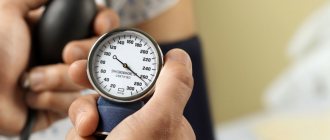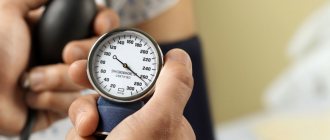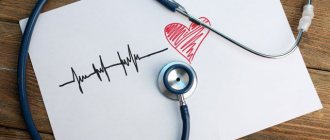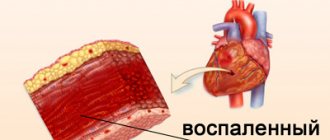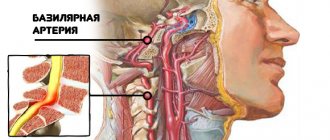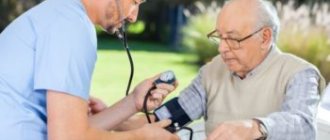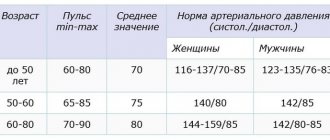The fatal pulse for a person is calculated according to the “220-age” principle, but official medicine believes that a pulse rate of 160-170 beats per minute can already lead to death. If such increases occur only after active physical activity, then they do not pose a danger to life, but achieving the indicated numbers at rest is a reason to call an ambulance.
Before death, a person’s pulse, on the contrary, decreases to its maximum – reaching 20-40 beats per minute, and may not be palpable at all. This is pre-agony, after which a short-term increase in heart rate is possible. First aid for a critically high pulse can be provided even without medical education - help the patient take the correct position, give Validol or Anaprilin tablets, and measure blood pressure.
Lethal pulse for a person: at what indicators can you die?
Lethal heart rate indicators for a person, at which one can die, are calculated using the standard formula:
220 – human age
For example, a man is 50 years old, which means that his deadly pulse rate is 170 beats per minute (220-50). It must be remembered that heart rate is considered an individual indicator, so the above formula can be used to obtain only average values - someone lives comfortably at 60-70 beats per minute, and for some people 90-100 will be the norm.
Official medicine believes that a pulse of 160-170 beats per minute can be fatal because:
- the heart's need for oxygen increases;
- the amount of circulating blood is not able to deliver the required “portion” of oxygen to the organ;
- acute hypoxia and heart failure occur.
Measurement methods
Many factors can influence your heart rate. Anxiety, stress, physical activity, and various diseases can increase heart rate values. To obtain an adequate result, it is important to take these factors into account. In order to know what your maximum heart rate is and prevent tachycardia, it is important to measure your heart rate from time to time. There are several ways to do this. You can measure your pulse either using instruments or simply by pressing the artery with your finger. The heart rate is best felt on the inner bend of the elbow, on the neck and on the wrist. By placing your finger on one of these places, you can easily count your pulse rate. A heart rate monitor in the form of a watch or bracelet measures heart rate more accurately. The use of heart rate monitors is possible when necessary or on an ongoing basis. Many companies produce these devices in the form of watches or bracelets that read indicators around the clock. This way you receive data about your health over a long period of time.
But the easiest way to measure your pulse is simply by touching it - this method does not require special equipment. The most common way to measure the number of heartbeats is at the wrist. To get an accurate result, you need to sit on a chair and put your hand on the table, completely relaxing it. Then count your pulse for 60 seconds, having previously set a timer.
Dangerous pulse for humans: causes
The causes of a dangerous pulse for a person can be:
- alcohol, drug addiction;
- acute lack of potassium and magnesium in the body;
- food poisoning, poisons, toxic gases;
- mental or nervous disorders;
- pathologies of the endocrine system that occur in severe stages.
Critically high pulse rates can also occur against the background of coronary heart disease, cardiosclerosis, myocarditis, heart defects of various nature and origin, acute blood loss, traumatic/mechanical damage to the heart muscle. Typically, the listed diseases are under the control of doctors - patients are registered, undergo regular examinations/diagnosis, and take specific medications on a regular basis.
But if there is no therapy, the patient does not get rid of bad habits and does not comply with the recommendations/prescriptions of the attending physician, then the death outcome against the background of the highest possible pulse rate is quite predictable.
Treatment
All medications for palpitations should be prescribed only by a cardiologist after a personal examination and the necessary tests. The most commonly prescribed drugs are:
- Anti-anxiety medications are effective in cases of emotional stress. This group includes medications such as Novopassit, valerian root, Afobazol. They can be purchased without a prescription, following the instructions for use.
- Medicines against arrhythmia reduce the heart rate and normalize it. The most commonly prescribed drugs are Verapamil, Adenosine and Flecainide. These medications can only be taken after a doctor's prescription.
In addition to the main treatment, the patient may be prescribed drugs that indirectly affect the cardiovascular system:
- Beta blockers normalize hormonal levels, which can be destabilized due to stress.
- Antioxidants.
- Cardiac glycosides.
But the most effective treatment method is still to prevent the occurrence of maximum heart rate. Doctors advise everyone who cares about their health to exclude fatty and spicy foods, alcohol and cigarettes from their diet. Regular exercise, such as running, strengthens the heart and improves endurance. A fully balanced diet of vegetables and fruits will provide the body with the necessary microelements. A lack of calcium negatively affects the heart, so it is important not to neglect this measure. Non-traditional treatments are also quite effective. Patients note significant improvement after acupuncture and herbal medicine. Quite often, an elevated pulse occurs along with high blood pressure, and it is important to address both problems at the same time.
How to feel a person's critical pulse
You can feel the critical pulse for a person by measuring the indicator in a standard way - on the wrist (from the inside), on the neck or in the groin area, on the elbow. Signs that you should check the pulse and take measures to save the person:
- blood pressure rises sharply;
- there are complaints of tinnitus;
- extremities begin to go numb and become cold (specifically, fingers and toes);
- large drops of sweat appear on the face.
The person begins to get nervous, he may be overcome by an attack of fear of death, and shortness of breath occurs. Complaints about darkening of the eyes and pain in the chest (the area of the anatomical location of the heart) are a signal that you need to immediately call an ambulance, because the patient requires resuscitation measures.
Diseases that may have a rapid heartbeat as a symptom
In cases where these causes of increased heart rate are excluded, it is necessary to consider a rapid pulse as a symptom of pathology. It may occur in the following cases:
- A number of cardiac pathologies - arrhythmia, myocardial dystrophy, cardiomyopathy, ischemic disease, arterial hypertension, heart disease, myocarditis. To exclude possible pathologies, you should consult a cardiologist.
- Vegetative-vascular dystonia. This pathology is also characterized by the development of symptoms such as dizziness, low blood pressure, and headache.
- Diseases of infectious origin. They are characterized by increased temperature and dehydration, which can affect heart rate.
- Poisoning.
- Climax.
- Endocrine system disorders. For example, dysfunction of the thyroid gland can be characterized by the development of symptoms such as increased irritability, weight loss, and long-term increased heart rate.
- Anemia. In addition to an increase in heart rate, it is characterized by general weakness and pale skin.
- Benign and malignant tumors.
In this regard, the appearance of a rapid pulse of up to 85 beats or higher in the absence of visible reasons is a direct reason to consult a specialist.
What might the pulse be like before death?
Before death, a person’s pulse slows down and can reach 20-40 beats per minute - this is the so-called preagonia. The condition is characterized by other symptoms:
- pain sensitivity is completely absent;
- consciousness is lost;
- pupils are constricted;
- the respiratory rate is 2-6 per minute and often cannot be determined at all.
In general, the transition from life to death is called a terminal state in medicine. It is characterized by the extinction of body functions, but not simultaneously, but gradually, and this is what allows, in some cases, to bring the patient back to life. After preagonia, when the pulse rate slows down, there are 3 more stages until biological death:
- terminal pause - the pulse cannot be felt at all, cardiac and respiratory arrest is observed, the duration of the stage is several seconds;
- agony - the body seems to be returning to life and this will be the last “outbreak”: the pulse and heartbeat quicken, blood pressure rises, breathing intensifies;
- clinical death - signs of life are completely absent.
Increased heart rate with low blood pressure
A pulse of 85 beats can be combined with reduced blood pressure in the following conditions:
- Hormonal changes during pregnancy.
- Cardiopsychoneurosis.
- Myocardial infarction.
- Extensive blood loss.
- Toxin poisoning.
- Anaphylactic shock.
Low blood pressure with a simultaneous increase in heart rate may be accompanied by other symptoms: a throbbing headache, mild or moderate pain in the heart, and an unpleasant sensation in the chest.
So, pulse is 85, what to do?
How to alleviate the condition if a person’s maximum permissible heart rate is
If a person has the maximum permissible pulse, then you need to call an ambulance and try to alleviate his condition:
- ensure the flow of fresh air - open the windows, unbutton or remove/cut clothes: nothing should restrict the patient’s chest or neck;
- position the person in a horizontal position so that the head is slightly higher in relation to the body and legs;
- wash it, sprinkle your face with cool water;
- give tincture of valerian or motherwort to drink;
- Place a Validol or Anaprilin tablet under your tongue.
It is highly advisable to measure the patient’s blood pressure before the doctor arrives. If it is elevated, then it is advisable to give him a tablet of Captopril, Verapamil or Metoprolol.
If signs of clinical death appear, then only 4 minutes remain in order to save a person with the preservation of all functions - as soon as problems begin in the blood supply to the cerebral cortex, the vital activity of the organs is reduced for a maximum of another 7 minutes, but after 5 minutes the brain cells begin to die brain against the background of acute oxygen starvation. What you can do:
- artificial respiration;
- heart massage.
The manipulations are performed according to a clear formula - for 30 clicks (“pumping” of the heart), 1 inhalation and exhalation are made. As soon as the pulse begins to be felt, a reaction to light appears, resuscitation can be stopped, because this indicates the patient’s return to life, although there may be no breathing for a few more minutes.
The fatal pulse for a person is calculated on a strictly individual basis, but an indicator of 160-170 beats is already considered critical. If the rate reaches 200 beats per minute at rest, then you need to call an ambulance - resuscitation measures are required to avoid death. Before the arrival of specialists, even a person without medical education can provide assistance to the patient.
Increased heart rate with increased blood pressure
High blood pressure along with a rapid heartbeat often occurs under the influence of normal causes, such as mental arousal and physical stress.
This phenomenon is explained by physiology: physical activity provokes the release of adrenaline, which, in turn, causes an increase in blood pressure and an increase in heart rate.
Therefore, if heart rate and pressure indicators are not critical, and other symptoms are not noted, the phenomenon can be considered a normal reaction of the body.
However, such a condition may also indicate the presence of certain pathologies:
- Respiratory system disorders.
- Oncological neoplasms.
- Anemia.
- Disturbances in the functionality of the thyroid gland.
In addition, high blood pressure can be life-threatening, so it is recommended to consult a doctor.
In what cases is 90 beats per minute an indication of pathology?
Possible diseases include:
- Hyperthyroidism. Excessive synthesis of thyroid hormones (T3, T4), as well as the thyroid-stimulating substance TSH, it is of pituitary origin.
Symptoms: palpitations, headache, vertigo, shortness of breath, fatigue, fatigue at any time of the day, problems sleeping, increased body temperature.
The causes of the disease-causing condition are improper diet, tumor pathologies.
- Hypercorticism. Excessive production of adrenal hormones, primarily cortisol. Neoplasia affects the organ itself or in the pituitary region.
The main clinical variant of the pathological process is Itsenko-Cushing syndrome. Accompanied by back pain, problems with the musculoskeletal system, sudden weight gain, fat deposition on the face like the moon.
The condition can be normalized surgically. Drugs are also used to neutralize the negative effects of cortisol (decreasing the sensitivity of specific receptors).
- Pathologies of the cardiovascular system. Including mitral valve stenosis, cardiosclerosis, myocardial infarction and consequences after the end of the acute period, pulmonary hypertension, and other processes of a similar kind.
The clinical picture is common: suffocation, shortness of breath, chest pain, low tolerance to physical activity and other manifestations. They require an assessment by a cardiologist; it is better not to delay visiting a doctor.
- Atherosclerosis of the aorta and its branches. It should be mentioned separately. The disease is accompanied by deposition of lipids (cholesterol) on the walls of blood vessels or acute narrowing of the lumen.
The inability to overcome resistance leads to increased cardiac activity.
We have to work more actively to provide the tissues with the necessary substances.
- Brain tumors. Usually the chiasmal-sellar region is affected. If they are large in size, they create a mass effect (compression), increase the pressure of the cerebrospinal fluid, which affects the condition of the cranial nerves. Treatment is surgical, and diuretics are also used to prevent compression.
- Kidney problems. Accompanied by lower back pain, urination disorders such as an increase in urine volume or frequent unsuccessful urge to empty the bladder. The properties of excrement change: color, smell.
- Diabetes. Deserves special attention. Destroys the entire body, including the cardiovascular system.
Finally, the heart rate increases due to the hypertensive process. A long-term illness is accompanied by severe, constant tachycardia.
A pulse of 92-95 and higher is the result of pathologies of the cardiovascular, excretory, and nervous systems. The cause can only be determined based on the results of special diagnostics.
Situations in which you should contact a specialist
You should seek professional help if:
- As the heart rate increases, the blood pressure level rises sharply.
- There are heart pathologies.
- The functionality of the thyroid gland is impaired.
- Has diabetes mellitus.
- There are known cases of sudden death of relatives from heart pathologies.
- Close relatives have problems associated with heart rhythm disturbances.
- There is a pregnancy.
- Each subsequent attack is more severe than the previous one.
When the condition is not acute, but attacks become more frequent for no apparent reason, it is important to consult a cardiologist as soon as possible.


